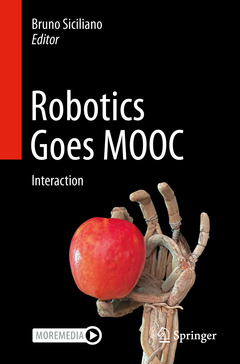Robotics Goes MOOC, 1st ed. 2024 Interaction
Coordonnateur : Siciliano Bruno

With the massive and pervasive diffusion of robotics technology in our society, we are heading towards a new type of AI, which we call Physical AI at the intersection of Robotics with AI, that is the science of robots and intelligent machines performing a physical action to help humans in their jobs of daily lives. Physical assistance to disabled or elderly people; reduction of risks and fatigue at work; improvement of production processes of material goods and their sustainability; safety, efficiency and reduction of environmental impact in transportation of people and goods; progress of diagnostic and surgical techniques are all examples of scenarios where the new InterAction Technology (IAT) is indispensable.
The interaction between robots and humans must be managed in a safe and reliable manner. The robot becomes an ideal assistant, like the tool used by a surgeon, a craftsman, a skilled worker. The new generation of robots will co-exist ? the cobots ? with humans not only in the workplace but, gradually, in homes and communities, providing support in services, entertainment, education, health, manufacturing and care.
As widely discussed above, interaction plays a crucial role for the development of modern robotic systems. Grasping, manipulation and cooperative manipulators are covered in the first part of the third book of the Robotics Goes MOOC project, respectively in Chapter 1 by Prattichizzo et al, Chapter 2 by Kao et al, and Chapter 3 by Caccavale. Specific interaction issues along with the development of digital and physical interfaces are dealt with in Chapter 4 by Marchal et al and in Chapter 5 by Croft et al, respectively. Interaction between robot and human also means that a robot can be worn by a human as presented in Chapter 6 by Vitiello et al. A different type of interaction at a cognitive and planning level is the focus of Chapter 7 by Lima devoted to multi-robot systems and Chapter 8 by Song et al on networked, cloud and fog robotics, respectively.
1 Prattichizzo, Grasping.- 2 Kao, Manipulation.- 3 Caccavale, Cooperative Robots.- 4 Hollerbach, Haptics and Virtual Reality.- 5 Croft, Human−Robot Interaction.- 6 Vitiello, Wearable Robots.- 7 Sukhatme, Multiple Robots.- 8 Song, Networked Robots.
Comprehensive reference book on robotics with MOOC supplement
Additional multimedia content accessible in browser or via SN More Media App
Provides numerous examples and exercises for senior graduate and PhD level students
Date de parution : 05-2024
15.5x23.5 cm
